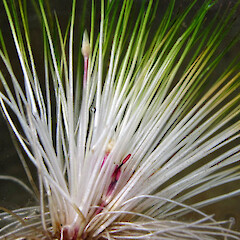Trithuria inconspicua
Synonyms
Hydatella inconspicua (Cheeseman) Cheeseman, Trithuria inconspicua Cheeseman subsp. inconspicua
Family
Hydatellaceae
Flora category
Vascular – Native
Endemic taxon
Yes
Endemic genus
No
Endemic family
No
Structural class
Herbs - Dicotyledons other than Composites
Chromosome number
2n = c.24
Current conservation status
The conservation status of all known New Zealand vascular plant taxa at the rank of species and below were reassessed in 2017 using the New Zealand Threat Classification System (NZTCS) – more information about this can be found on the NZTCS website. This report includes a statistical summary and brief notes on changes since 2012 and replaces all previous NZTCS lists for vascular plants.
Please note, threat classifications are often suggested by authors when publications fall between NZTCS assessment periods – an interim threat classification status has not been assessed by the NZTCS panel.
- Conservation status of New Zealand indigenous vascular plants, 2017 . 2018. Peter J. de Lange, Jeremy R. Rolfe, John W. Barkla, Shannel P. Courtney, Paul D. Champion, Leon R. Perrie, Sarah M. Beadel, Kerry A. Ford, Ilse Breitwieser, Ines Schönberger, Rowan Hindmarsh-Walls, Peter B. Heenan and Kate Ladley. Department of Conservation. Source: NZTCS and licensed by DOC for reuse under the Creative Commons Attribution 4.0 International licence.
2017 | Threatened – Nationally Critical | Qualifiers: RR
Previous conservation statuses
2012 | Threatened – Nationally Endangered | Qualifiers: EF, PD, RR
2009 | Threatened – Nationally Vulnerable | Qualifiers: RR
2004 | Serious Decline
Brief description
Diminutive, tufted, aquatic herb 15–55 mm tall producing numerous unsheathed fine hair like leaves arranged in fans. Inflorescences inconspicuous, borne on stalks 20–40 mm long. Flowers much reduced, male, flower or bisexual. Male flowers with obvious red stamens. Female flowers much reduced reddish.
Distribution
Endemic. New Zealand: North Island (Northland, where it is known from western dune lakes from near Awanui to the Pouto Peninsula).
Habitat
An aquatic of shallow to medium depth (5–7 m) freshwater lakes (exact depth range dependant on water quality and light levels), preferring reasonably stable substrates but has been found growing in fine sand, gravel and organic muds. Apparently intolerant of surrounding taller vegetation. Mature plants are often partially buried in sediment so that only their upper most leaf tips are exposed.
Wetland plant indicator status rating
Information derived from the revised national wetland plant list prepared to assist councils in delineating and monitoring wetlands (Clarkson et al., 2021 Manaaki Whenua – Landcare Research Contract Report LC3975 for Hawke’s Bay Regional Council). The national plant list categorises plants by the extent to which they are found in wetlands and not ‘drylands’. The indicator status ratings are OBL (obligate wetland), FACW (facultative wetland), FAC (facultative), FACU (facultative upland), and UPL (obligate upland). If you have suggestions for the Wetland Indicator Status Rating, please contact: [Enable JavaScript to view protected content]
OBL: Obligate Wetland
Almost always is a hydrophyte, rarely in uplands (non-wetlands).
Detailed description
Aquatic perennial herb, tufted 15–55 mm high, from a shortly branching erect rhizome, trichomes present; copious adventitious roots. Apomictic or sexual. Plants in populations often female only, or plants co-sexual with unisexual or bisexual reproductive units. Leaf-bases weakly dilated (not sheathing), hyaline, toothed auricles present or absent. Leaves spreading, glabrous, 15–55 × 0.25–0.4 mm; lamina linear-filiform, adaxially faintly compressed below, terete above, apex rounded with a hydathode. Reproductive units 1–4 per tuft, (3.5)–4–5–(7) mm long, on glabrous terete scapes 20–40 × 0.3–0.4 mm; involucral bracts 2–4–(7), male reproductive unit bracts 3.5–5.0 mm long, ovate to narrow-ovate, stamens (1)–3–8; anthers 0.8–1.4 mm long, bright red, filaments 1–5 mm long; bisexual reproductive unit bracts 4–5 mm long; stamens 1–5; carpels 2–10; female reproductive unit bracts 2.5–5.0 mm long. Carpels 8–24, reddish, with 5–13 stigmatic hairs of unequal length, 0.3–1.0 mm long, red becoming hyaline. Fruits 0.4–0.56 × 0.2–0.4 mm, ellipsoid to ovoid, deciduous from persistent stalks, pericarp thin and membraneous, smooth, indehiscent. Seed faintly reticulate, yellowish-brown to reddish-brown with a darker apical cap (formed by an operculum).
Similar taxa
Trithuria inconspicua is most likely to be confused with some of the spike rushes (Eleocharis spp.) and species of Centrolepis. From these Trithuria differs by its submerged flowering habit, with the male and female flowers usually separate; by the male flowers which have much longer filaments and 2-celled anthers; and by the female flowers which have septate styles that are septate. Vegetative material of Trithuria differs from Centrolepis in that the leaves are not sheathed. Trithuria could be confused with sterile plants of Eleocharis pusilla, however, E. pusilla has uniformly bright green leaves arising from a creeping rhizome. Trithuria brevistyla differs from T. inconspicua by the possession of shortened stigmatic hairs that form a knobbly capitate head; by the void to globose (rather than ellipsoid to ovoid), and by the scapes which do not elongate at maturity.
Flowering
October–December
Flower colours
Red/Pink, Yellow
Fruiting
December–February
Propagation technique
Difficult. Should not be removed from the wild.
Threats
Seriously threatened in Northland due to the recent spread of the introduced bladderwort Utricularia gibba, and also by the continuing spread of oxygen weeds into these important lakes. Indeed, as of 2004, it has been confirmed as extinct in two more Far North dune lakes.
Etymology
inconspicua: Inconspicous
Attribution
Fact Sheet by P.J. de Lange (6 January 2004). Fact sheet updated by P.J. de Lange (4 February 2019). Description based on Smissen et al. (2019).
References and further reading
Smissen RD, Ford KA, Champion PD, Heenan PB. 2019. Genetic variation in Trithuria inconspicua and T. filamentosa (Hydatellaceae): a new subspecies and a hypothesis of apomixis arising within a predominantly selfing lineage. Australian Systematic Botany 32(1): 1–11. https://doi.org/10.1071/SB18013.
NZPCN Fact Sheet citation
Please cite as: de Lange, P.J. (Year at time of access): Trithuria inconspicua Fact Sheet (content continuously updated). New Zealand Plant Conservation Network. https://www.nzpcn.org.nz/flora/species/trithuria-inconspicua/ (Date website was queried)











